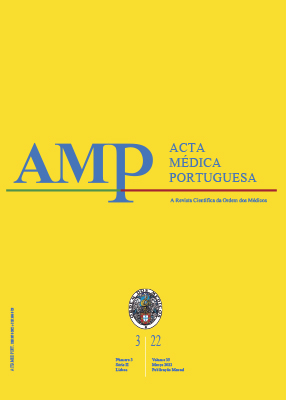Therapeutic Plasmapheresis: Seven Year Experience of an Intensive Care Unit in Portugal
DOI:
https://doi.org/10.20344/amp.14266Keywords:
Critical Illness/therapy, Plasma Exchange/methods, Plasmapheresis/adverse effects, Plasmapheresis/methods, Plasmapheresis /therapeutic useAbstract
Introduction: Therapeutic plasmapheresis is a therapeutic procedure in which the patient’s blood is passed through a medical device which separates out plasma from other components of blood. The plasma is removed and replaced with a replacement solution. Studies on the use of plasmapheresis in critically ill patients are scarce. The aim of this study was to review all therapeutic plasmapheresis sessions carried out in the Hospital Beatriz Ângelo intensive care unit.
Material and Methods: An observational retrospective study was conducted between April 2012 and March 2019. All patients who underwent therapeutic plasmapheresis in the intensive care unit were included, and plasmapheresis sessions held outside the intensive care unit were excluded.
Results: Of 46 patients, 63% were men (n = 29), with a median age of 53 years. The most frequent diagnoses were hypertriglyceridemia-induced pancreatitis, vasculitis, autoimmune haemolytic anaemia, and atypical haemolytic-uremic syndrome. A total of 198 plasmapheresis sessions were carried out in the intensive care unit. Most of the used replacement solutions were fresh frozen plasma (34.4%), albumin/crystalloid (24.2%), and albumin/fresh frozen plasma (19.2%). The most common complications were hydroelectrolytic changes (84; 42.4%) and coagulation disorders/thrombocytopenia (65; 32.8%). There was no need to interrupt any plasmapheresis session due to complications related to the patient.
Conclusion: Therapeutic plasmapheresis is a complex technique that requires specific training. The indications are diverse, and some are not consensual. Complications were frequent, but they did not increase morbidity.
Downloads
Downloads
Published
How to Cite
Issue
Section
License
Copyright (c) 2021 Acta Médica Portuguesa

This work is licensed under a Creative Commons Attribution-NonCommercial 4.0 International License.
All the articles published in the AMP are open access and comply with the requirements of funding agencies or academic institutions. The AMP is governed by the terms of the Creative Commons ‘Attribution – Non-Commercial Use - (CC-BY-NC)’ license, regarding the use by third parties.
It is the author’s responsibility to obtain approval for the reproduction of figures, tables, etc. from other publications.
Upon acceptance of an article for publication, the authors will be asked to complete the ICMJE “Copyright Liability and Copyright Sharing Statement “(http://www.actamedicaportuguesa.com/info/AMP-NormasPublicacao.pdf) and the “Declaration of Potential Conflicts of Interest” (http:// www.icmje.org/conflicts-of-interest). An e-mail will be sent to the corresponding author to acknowledge receipt of the manuscript.
After publication, the authors are authorised to make their articles available in repositories of their institutions of origin, as long as they always mention where they were published and according to the Creative Commons license.









